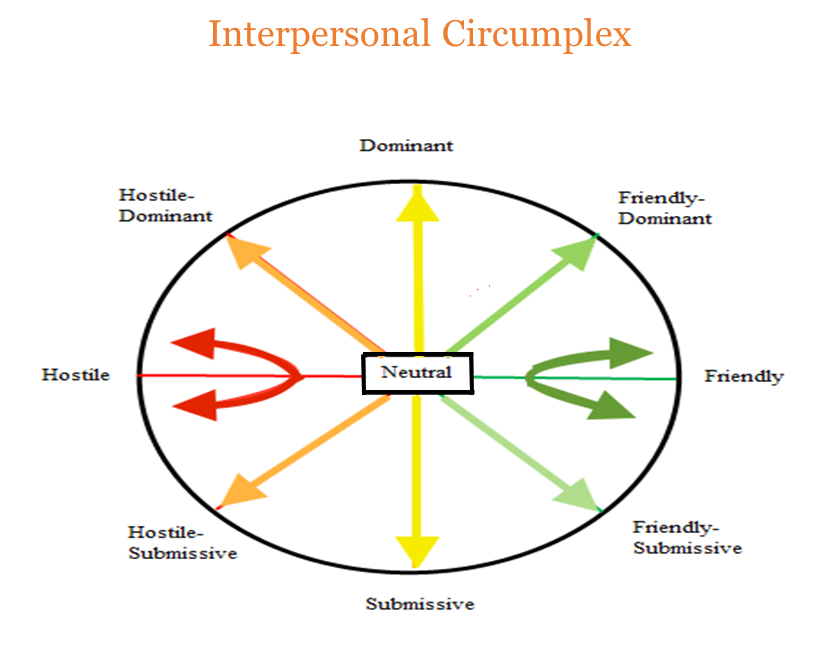Even when we want to be alone, we don’t want to remain alone. But when we find ourselves divided by strong feelings, we often do not fully understand them or know how to communicate them. And as these experiences persist and become chronic, the divide may come to look unbridgeable. It’s at this point that people usually seek help, and a major challenge facing any professional third party is how to help their clients see the situation more clearly. A model that can generate insight into these chronic patterns of relational strain and how to overcome them is the Interpersonal Circumplex.
The Problem
In a marriage or committed relationship, and even in a close collaborative relationship at work, we learn to read the other’s negative moods even before they are overtly expressed. Our notice of these moods may not immediately rise to full conscious awareness. We’ll first feel their presence as a growing tension accompanied by an inclination to be cautious about what we say. Indeed, others often count on their behavior having this effect. Deep down, they want us to notice their mood shift, it sends a message.
These moods affect our reactions and generate self-talk. In the aggrieved party it may take the form of, “Why do others make life so difficult for me?” or “I don’t have the patience to deal with this anymore!” These are not neutral thoughts, they reflect feelings of strain and pain, which only intensify when they remain unexpressed. But if we can relax our fears and inhibitions and adopt a positive attitude, perhaps we and the other (intimate or colleague) might find ways to talk about what divides us, even resolve it.
Of course, the non-aggrieved party, will have their own self talk in response to the implicitly expressed mood of the other: “There it is again; something’s wrong and they won’t let me in on their feelings!” or “Something is off, I can feel it.” Our discernment of the tension is usually accompanied by inhibitions that prevent us from expressing what we are noticing and feeling. Neither we nor they are ready to risk that. So, how we do break this circular conspiracy of silence that allows the mooded state to fester?
Enter the facilitative presence of a third party, as coach or as therapist. How do they help? It begins with empathic understanding and accurate insight into the inhibiting forces affecting the clients: “Okay, I can see how they notice the mood but suppress expression of what they notice. Now, how can I help them become aware of this chronic pattern sooner and generate alternatives to suppressing expression of what they see, actions that serve to de-escalate emotions and work toward resolution?”
This is when the professional begins to frame the challenge for the clients. First, it’s about assuring them that they are doing nothing but trying to keep themselves safe and avoid conflict. Second, it’s about how their present actions fail to achieve their goals, how their fears restrain expression of what they notice, thereby relegating them to the fight-or-flight level of “lower brain” function and blocking transmission to the “upper brain” where a more equanimous attitude and reasonable qualities of mind prevail.
The Interpersonal Circumplex (IPC)
The IPC has two axes, both expressing basic human needs in interpersonal relations. The vertical axis (Dominant-Submissive) concerns the expressive and receptive qualities of human behavior. In that sense, these descriptors can be deceiving, for none of us want to be dominated or reduced to a submissive role. Rather, these terms represent the extreme poles of a continuum that reflects our needs for control, i.e., to freely assert ourselves and to be heard, and to listen and to understand what others have to say.
The horizontal axis (Hostile-Friendly) represents our basic needs for affiliation. We are social beings and feel safest and most open to hearing others when we experience friendliness or warmth from them. So, even if they express these positive emotions in a reserved style, it disarms defensive feelings that close us off to communication. The length of the vectors originating in the center of the circle represents the affective strength of the behavior being expressed. And Neutral represents a “place” of reflective pause.

Coaching Guidance
Based on observation, the professional helps raise the clients’ awareness of the behaviors that tend to produce and sustain patterns of chronic strain or conflict (behaviors on the left side of the circle) and helps them acquire skills for noticing rising tension early and for expressing it appropriately and with empathy. This helps them shift interaction that may be trending hostile to the Neutral Zone, and from there to the right side of the circle where they take turns talking and listening empathically to achieve mutual understanding and to promote goodwill.
Back and forth discussion in the friendly side of the circle helps them come to appreciate their individual differences and ro recognize triggers that activate their defenses and impede communications. With this insight and regular practice (homework), they can become more skilled at noticing when and maybe why tensions are growing. Their growing skills in mindfully noticing escalation and tension as a cue for moving interaction to the Neutral Zone becomes more natural. Fears that inhibit communication lessen.
Here is a typical message I might deliver to clients as they leave a session with homework to use the IPC as a mental model for noticing tension and moving interaction to the Neutral Zone:
-
When you first notice that you are feeling the familiar tensions and negative emotions, know that this awareness is important. Welcome it, knowing that you are already gaining more control over your chronic reactive tendencies, and that you now have choices. That is your first step in breaking the chronic cycle of dysfunctional interaction and it’s a critical achievement.
-
Now, what can we then do with this awareness? Our notice that there is tension grants us some emotional distance from tension. We are no longer totally immersed in it; it has now become the object of our awareness. So, we can speak with less fear: “I am feeling that things are a bit tense, and we may be seeing things differently or feeling differently right now.”
-
And this “process observation” may lead us to some further communication: “It feels like one of those moments we talked about in our last therapy/coaching session when it may be helpful to go to the Neutral Zone and start again so we can make sure we are hearing and understanding one another accurately. What do you think?”
-
Remember, it is not unusual that our first efforts may fall short. It’s a learning process, so be ready to try again while maintaining a calm and patient attitude, giving the other person time to feel the sincerity and goodwill in your message. Importantly, it doesn’t matter who starts the move to the Neutral Zone; it’s not a competition.
The expert has the benefit of specialized training and is positioned to see things from the outside. They are sought out with the hope that they will be able to help change the dynamics of the relationship. Still, lasting change takes time, and the coach and clients gain traction in waves. Initially, it consists of calming fears, increasing self and other awareness, and building confidence. Transformational changes in insight become more possible as clients become more trusting, open, and ready to use the mental model.
Note: A classic resource on Interpersonal Theory for professionals who wish to know more about the model and related research is Contemporary Interpersonal Theory and Research by Donald Kiesler, John Wiley & Sons (1996).





